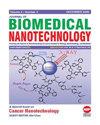氧化锌纳米粒子(ZnO NPs)处理两种骨肉瘤细胞系以鉴定差异表达基因
IF 2.9
4区 医学
Q1 Medicine
引用次数: 0
摘要
骨肉瘤(OS)主要发生在青少年,男性比女性更普遍。它的特点是局部浸润性生长和早期肺转移。纳米粒子(NPs)由于其高选择性和有效性而成为传统化疗药物的一个有希望的替代品。以前的研究已经证明氧化锌纳米颗粒(ZnO NPs)作为除肿瘤外的各种肿瘤的治疗潜力。在这项研究中,我们使用RNA-seq分析来研究ZnO nps处理不同类型OS细胞系过程中涉及的潜在生物学机制。我们在143B和MG-63细胞中鉴定了928个差异表达基因(deg),并使用RT-qPCR验证了8个最显著的deg的表达。基因本体(Gene Ontology, GO)分析显示,在两种OS细胞系中,转录因子在分子功能方面调控了核酸结合,在细胞组分方面调控了细胞外空间。此外,京都基因和基因组百科全书(KEGG)分析显示,MAPK、toll样受体和NF-κB通路在两种OS细胞系中共同富集。蛋白-蛋白相互作用(PPI)分析强调了HMOX1、MAFB、CXCL10和CXCL11参与氧化锌NPs处理的OS细胞的各种生物过程。此外,我们利用Western Blot (WB)技术确认了两种OS细胞系差异信号通路中的关键蛋白分子。我们的研究结果揭示了ZnO NPs治疗OS的潜在抗肿瘤机制和可开发的生物效应。本研究为ZnO NPs的处理提供了更多的靶点和可能的机制,也为OS的处理提供了更多的理论依据。本文章由计算机程序翻译,如有差异,请以英文原文为准。
Zinc Oxide Nanoparticles (ZnO NPs) Treated Two Types of Osteosarcoma Cell Lines for Identifying Differentially Expressed Genes
Osteosarcoma (OS) primarily accurs in adolescents, and is more prevalent in males than females. It is characteristics by local invasive growth and early pulmonary metastases. Nanoparticles (NPs) have emerged as a promising alternative to traditional chemotherapeutic drugs due to their
high selectivity and effectiveness. Previous studies have demonstrated the potential of zinc oxide nanoparticles (ZnO NPs) as a treatment for various tumors except OS. In this study, we use RNA-seq analysis to investigate the underlying biological mechanism involved in the process of ZnO NPs-treated
different types of OS cell lines. We identified 928 differentially expressed genes (DEGs) in both 143B and MG-63 cells, and we validated the expression of the eight most significant DEGs using RT-qPCR. Gene Ontology (GO) analysis displayed regulation of transcription factor on nucleic acid
binding in molecular function term, and extracellular space in cellular components term in both OS cell lines. Additionally, Kyoto Encyclopedia of Genes and Genomes (KEGG) analysis revealed the co-enrichment of the MAPK, Toll-like receptor, and NF-κB pathways in both OS cell lines.
Protein–protein interaction (PPI) analysis highlighted the involvement of HMOX1, MAFB, CXCL10, and CXCL11 in various biological processes in OS cells treated with ZnO NPs. Furthermore, we confirmed the key protein molecules in the differential signaling pathways of both OS cell lines
using Western Blot (WB). Our findings shed light on the potential antitumor mechanisms and exploitable bioeffects of ZnO NPs in the treatment of OS. This study provides more targets and possible mechanisms for the treatment of ZnO NPs, as well as more theoretical basis for the treatment of
OS.
求助全文
通过发布文献求助,成功后即可免费获取论文全文。
去求助
来源期刊
CiteScore
4.30
自引率
17.20%
发文量
145
审稿时长
2.3 months
期刊介绍:
Information not localized

 求助内容:
求助内容: 应助结果提醒方式:
应助结果提醒方式:


